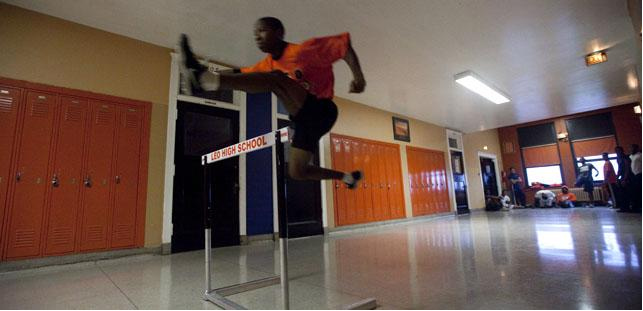Cedric Wynne practices his hurdling technique during track practice at Leo High School. Despite not having an indoor or outdoor track to practice on the team works out in the halls of the high school and won the IHSA state tournament last year.
by IDALMY CARRERA | Feb 27, 2012
In sports, it’s about numbers.
Leo High School won their latest track and field state title last May by one point. This marked the school’s sixth state championship. When Leo won its first state title in 1981, it became the first Catholic school to take the top trophy in track and field, and no other Catholic school in Illinois has done that since then.
But the biggest number for the Leo track team may well be zero. That is the number of indoor and outdoor practice facilities the team has–none at all meaning one of the state’s top track teams trains by running laps and hurdles in the school’s hallways after class.
Leo is hardly the only school dealing with sub-par practice facilities: In fact, no Chicago public school has an indoor track. But Leo is the only Chicago school to win a state title in track and field in the last 15 years, a championship no Chicago Public Schools team has claimed since 1974.
“I think it would be easy to get a case of the poor-me’s based on a lack of facilities,” said Jim Prunty, president of the Chicago Catholic League. “But the fact of the matter is that in Chicago, you would be hard pressed to find a school with really great facilities. It’s a reality we’re all dealing with.”
The Illinois High School Association surveys high schools every year on its website regarding track and field facilities at state schools in order to determine postseason sites. However, many schools do not complete the survey, making it difficult to determine how many of the 777 IHSA schools have their own tracks.
“It’s not uncommon for teams all over the state to be running the halls or the stairs if they want to get started on conditioning early. Most schools in Illinois don’t have an indoor facility,” said Ron McGraw, an assistant executive director with the IHSA.
“Having facilities doesn’t make you a state champion and not having them obviously doesn’t keep you from succeeding.”
Track and field hit its peak in the U.S. almost three decades ago when American athletes consistently brought home Olympic medals for the sport. Its low visibility since then has been one of the reasons why fewer young athletes get involved with the sport. Funding for track and field programs also has dropped, said a spokesperson for USA Track and Field.
In 2010 CPS cut pay for assistant high school track coaches in an effort to save money in the district’s budget. According to information provided by CPS, there about 70 high schools with track and field teams. Eighteen schools have outdoor facilities on school property or at a nearby park, and four schools have stadiums with surrounding tracks that can be used for track meets.
At Leo–a Catholic school that is not part of CPS–the track and field team works on technique and conditioning in the school’s weight room, hallways and stairwell landings beginning in January. Any day that weather permits, they move practice outdoors to the sidewalks or nearby woods because almost any other surface, said head coach Ed Adams, is better on the athletes’ bodies than the hallway floors that have no give.
Adams has worked at Leo 17 years. Under his leadership, the Lions have won five of their six state trophies. He has done so despite a steep decline in school enrollment that finally leveled off in the last couple years.
Today, there are 148 students at the all-boys Catholic school that in its heyday enrolled more than 1,000. Chicago News Cooperative sports columnist Dan McGrath since the summer of 2010 has served as president of the school, which continues to face enrollment and financial challenges.
Adams, who has received a combined eight coach-of-the-year plaudits from the National Federation of State High School Associations and the Illinois Track and Cross Country Coaches Association leads a team of 30–or about 20 percent of the school’s student body.
“Track and field relies heavily on individual talent available in your school,” Adams said. “It’s not easy to build, say, a powerhouse.”
Of the six students who represented Leo at the state track meet last year, five graduated and the other is now a sophomore. That athlete, Theo Hopkins, remembers spraying his teammates with water to celebrate the state championship.
“You know how teams in the pros do that with champagne? Well, we did it with water,” said Hopkins, 15. “Then we remembered we’re supposed to always be polite so we just got on the buses quietly and came home.”
The team is in a rebuilding year in a sport where success can be fleeting. Leo’s prior state win was in 2003.
“It doesn’t matter that we don’t have tracks or anywhere but the halls to practice on,” said Hopkins. “I want people to know that at Leo we don’t need a track because we work hard and that’s why we can win.”









Speak Your Mind